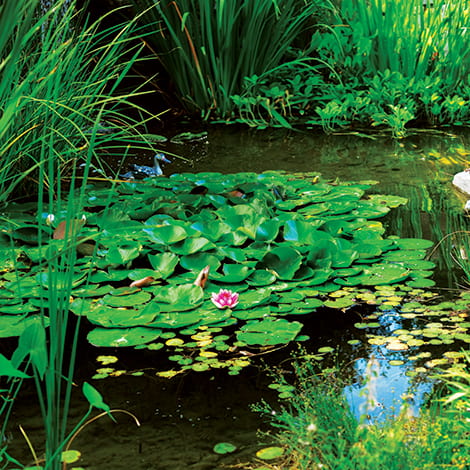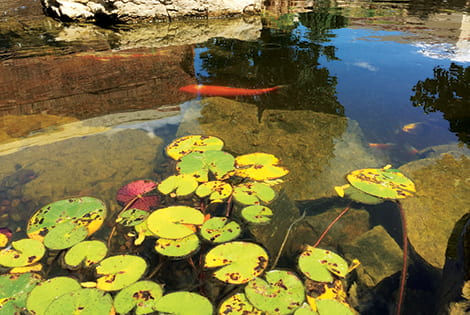Last Updated: March 4, 2024
The greenery in your pond or water garden is vital to keeping an attractive and balanced aquascape. Aquatic plants require seasonal maintenance to flourish and bloom. Learn how to care for pond plants from spring start-up to fall shut-down in this aquatic plant care guide.
Divide Plants in Spring
When the ice starts to melt, it means that spring start-up is just around the corner. Start the pond season by thawing your green thumb and dividing your aquatic plants so they can stretch their roots.
Depending on growth, you should divide bog plants every one to two years, while water lilies and lotus can be divided every two to three years. Below is a simplified guide on how to divide pond plants, so grab your pruning tools, gloves, planting bags, planting soil, planting media, and garden hose, and let's get to work!
Bog Plants
Bog plants include corkscrew rush, dwarf cattail, and blue flag iris species. These plants have clumping roots, runners, or rhizomes, and the dividing process will vary slightly based on the root type. Here's what to do:
- Lift the aquatic plant pot out of the water and gently remove the root mass.
- Wash the soil off the roots with your hose and trim any dead foliage.
- Divide the root mass depending on the type of root system. For plants with clumping roots like corkscrew rush, separate the roots into sections with some roots intact in each section. Dwarf cattails have runners, so cut the runner and leave the root base with each plant section. Gently divide rhizome plants like irises into sections.
- Replant each section in a container with a mix of aquatic soil and planting media and dispose of any overgrowth. Explore our Bog Plant Kits to get all your replanting supplies in one stop.
Water Lilies & Lotus
Water lotus and water lilies, tropical and hardy varieties, are also relatively easy to divide. These plants have a tuber root system like a potato. When you notice fewer lily pads, reduced blooms, or splitting pots, you will know it is time for the tubers to go their separate ways.
- Lift the container out of the water, locate the tuber, and gently remove it.
- Rinse off the soil and trim excess root growth and dead leaves.
- Identify the crowns—buds where the pad will sprout—and divide them with a sharp knife. These sections will become new plants, so ensure each piece is 3–4" long.
- Plant each section horizontally in separate containers, angling the growing tips to be exposed above the planting media.
- Place your repotted plants in a shallow area with 3–6" of water above the growing tip.
- Once leaves emerge above the water’s surface, you can move containers to deeper waters. Try our Water Lily and Lotus Planting Kits to simplify replanting—the small kit accommodates one lily, while the large kit can fit two lilies or one lotus.
Fertilize & Tend Through Summer
Ensure your plants get the nutrients they need to produce vigorous blooms by adding pond plant fertilizer every two weeks during the growing season. Regularly remove any dead foliage to keep your colorful beauties looking their best.
Winter Care for Pond Plants
As the temperatures cool and you shut down your pond, you will want to give your plants extra attention before the winter chill. If you live in a frost-free zone, congratulations! All you need to do is follow your summer routine. For those who get a bit frosty, the pointers below will help you prepare your plants for winter.
Know Your Zone: Like terrestrial plants, aquatic plants are sensitive to varying temperatures. The USDA Hardiness Zone Map is based on the average minimum winter temperature and is the basis for determining which plants will thrive in a particular location. Start by identifying which plants are and aren't in your zone, then do the following:
- Hardy Plants: Hardy water lilies, submerged plants, and other plants geared for your hardiness zone are simple to winterize. Remove the foliage after the first hard frost, then gently sink your hardy plants to the deepest part of the pond to go dormant until spring. Bring bog plants back up as soon as the ice permanently thaws so they can keep growing. Some exceptionally hardy bog plants, like creeping jenny pond plants, will survive and flourish without winter protection.
- Floating Plants: Water lettuce and other floating plants are most susceptible to frost. It is best to treat them as annuals and discard them after the first frost. Luckily, they are inexpensive to replace and will quickly grow when added in spring.
- Tropical Bulbs: Lilies, canna, and other plants with bulbs or tubers that prefer temperatures above your climate should take a winter vacation from your water garden. These plants can either go dormant, or you can try your hand at growing them indoors.
- Tropical Bog Plants: The yellow water snowflake—ironically not tolerant of snow—and other tropical bog plants can be treated as annuals, or you can bring them inside to test your gardening skills. If you try wintering these plants inside, you will want to keep them wet, but standing water is unnecessary. Keep in mind that as the days shorten, you will likely need to provide supplemental light so they can get their 10–14 hours.
More Pond Plant Care Questions
Taking year-round care of your plants will ensure they last through the seasons and over the years! If you have additional questions, contact our pond professionals at 866-766-3435 or check out the following aquatic plant care guides:
How to Plant Water Lilies
Triming Aquatic Plants
Lilies With No Flowers
How to Pick Pond Plants

